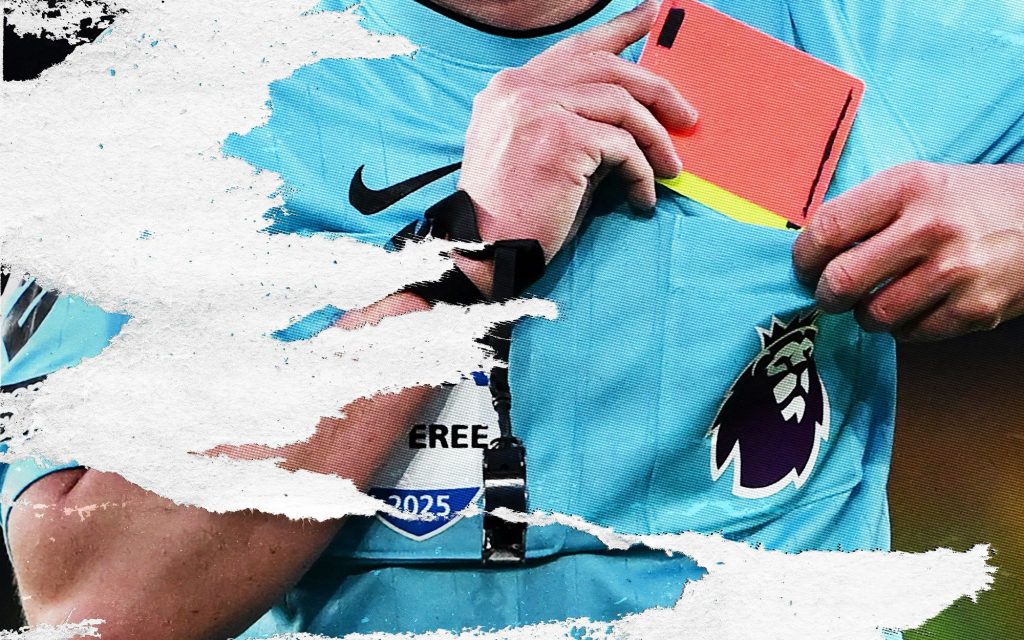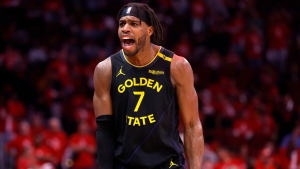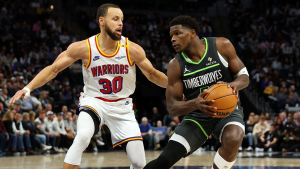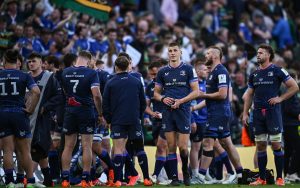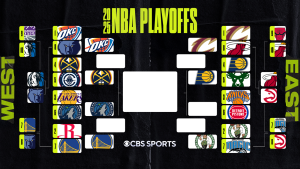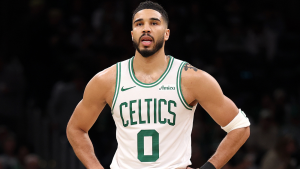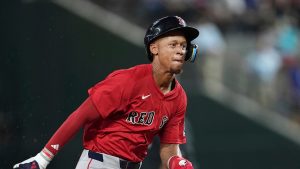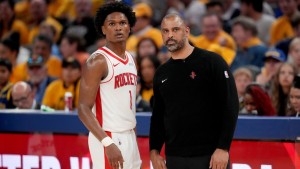
Earlier in the VAR era, the Premier League’s video match officials began to notice something strange: at one ground a camera would regularly disappear after 75 minutes. When they asked why, they were told it was needed elsewhere – in readiness for post-match interviews.
If that seems unlikely in the wealthiest domestic football league in the world, then it does illustrate the challenging circumstances in which the referees’ and assistants’ organisation, Professional Game Match Officials Limited (PGMOL), sometimes has to operate.
The primary issue is financial: PGMOL is bleeding money. Howard Webb, the chief refereeing officer, will announce new losses next week of £900,000. In addition, losses of £379,000 last year have been adjusted upwards to £1.8 million, taking the cumulative total over three years to around £3.4 million. Webb is ready to tell clubs they must commit to bigger long-term budgets if they want the gold standard of refereeing.
Webb is also on the cusp of introducing huge change internally with, for the first time, referees facing relegation from the prestigious select group one (SG1) that takes charge of Premier League games as part of a wider restructure.
VAR incorrectly believed that Luis Diaz’s disallowed goal had been awarded on-field 🔴
The ‘check complete’ was supposed to signal that the goal should have stood ⚽✅ pic.twitter.com/0qOJmYjpsM
— Sky Sports News (@SkySportsNews) October 1, 2023
PGMOL believes that since the Luis Diaz VAR debacle over his disallowed goal against Tottenham Hotspur in October 2023, there have been very few errors. Off the pitch, the David Coote affair caused embarrassment but the challenge is of a different flavour now. Will clubs continue to fund PGMOL at the level that Webb and its senior executives believe it needs to reach a level where it is the best in the world?
In addition, Telegraph Sport has learned:
- As well as demotions from SG1, there is likely to be a merger between that top group and select group two referees (SG2) who officiate Championship and League One and Two games
- There are worries among officials about the new semi-automated offside technology (SAOT), provided by Genius Sports, which uses a different staff to the chief VAR contractor Hawk-Eye
- VAR camera coverage at Premier League grounds is inconsistent from stadium to stadium
- Referees’ bonuses are based on the assessments of the Key Match Incident review (KMI) panel – a group of former players and former coaches whose verdicts on decisions often jar with the referees
- Many of the SG1 referees rebelled against former colleague Jonathan Moss last year after he was placed in charge of the top tier of Premier League referees
- PGMOL uses Loughborough University, rather than the FA’s St George’s Park, for the SG1 and SG2 monthly meetings because the latter is too small
- The two dedicated psychologists for the leading referees both left PGMOL at the start of the year and have not yet been replaced
- PGMOL has made plans to cover a potential tax bill from HMRC over a decade-long case that has gone to the Supreme Court over whether lower league referees can be treated as self-employed
An organisation accustomed to scrutiny
As is the custom, the 20 SG1 referees met at Loughborough last month along with their assistants and the SG2 referees – around 100 men and women who are the full-time professionals of PGMOL’s 350-strong list of officials. PGMOL is responsible for the top four divisions, the National League, the Women’s Super League and the Under-21s Premier League 2. Joint-owned by the Premier League, the Football League (EFL) and Football Association, PGMOL is accustomed to scrutiny.
The introduction of VAR has added hundreds of work hours and millions in costs. The views espoused by high-profile pundits, 24-hour news and relentless social media can be brutal. The Coote affair, in which private videos of the SG1 referee making indiscreet remarks were leaked, was mortifying for the profession. It was 14 months after the Diaz goal, when VAR Darren England mistakenly confirmed an on-field decision when in fact he was trying to do the opposite.
The referees, however, heard that major change is coming. Some of them will be managed out of SG1, while others may find themselves falling down a hierarchy that was once as hard to descend as it was to climb. Stuart Attwell’s temporary demotion in 2012 was the last time a referee dropped out of SG1 aside from retirements. But Webb, and the Premier League, are determined to fast-track new blood, in particular those on its elite referee development plan (ERDP), including the likes of Sam Barrott, Lewis Smith and Sam Allison.

There is a bigger picture: funding for referees and assistants has stagnated. PGMOL’s current budget remains around £33 million. The lowest-placed Premier League club earns £110 million and that will rise when the new broadcast deal kicks in next season. Inflation, as well as the cost of VAR and all the training hours, equipment, and the lease of the Stockley Park hub, has seen costs spiral. The recasting of the previous losses, up to the financial year ending July 2023, was done to include farewell payments for referees leaving the profession.
Webb and chief operating officer Danielle Every want a multi-year deal with PGMOL’s three funders, similar to those the Premier League and EFL sign with broadcasters. Currently they work year to year, with reserves covering losses and an agreement from their funders to underwrite the organisation.
Webb arrived in December 2022, the most famous referee in the history of the English game, to take over from his former boss Mike Riley. As a former World Cup final and Champions League final referee and with 11 years in the Premier League, Webb commands the respect of the officials – not just for his career but also for his openness with them and a readiness to be challenged, something that has not always been the case at PGMOL. But no one doing his job is ever popular with all his referees.
Facing challenges at every level
PGMOL and its officials face challenges at every level, but nowhere more than the implementation of VAR and its latest technology bolt-on, the SAOT. Officials expected that the new system introduced this year would be the same used by Fifa, the tried-and-tested Hawk-Eye system. Instead, they were told it was another contractor, Genius Sports, which had won the tender run by the Premier League.
#IPSLIV – 53′
VAR confirms the on-field referee’s call of offside on Davis before the potential penalty check for the challenge by van Dijk on Delap. pic.twitter.com/rE2R4eIoiU
— Premier League Match Centre (@PLMatchCentre) August 17, 2024
It can calculate straightforward offsides when the ball is played forward through the defensive line. It is less certain when the ball takes multiple touches in the box towards and away from the goal and then back again. Then the referees may have to manually adjust the system to take into consideration touches that the software misses. At the VAR hub at Stockley Park, just north of Heathrow Airport, Hawk-Eye has been used for VAR since its introduction in 2019. The replay operators (ROs) are Hawk-Eye employees and it is their job to replay the footage from the angles the VAR requests when a decision is being checked. Up to three can be allocated to a single game depending on how many cameras are available.
But once the decision switches to offside now, the VAR has to deal with Genius Sports’ contractors who will be building the semi-automated image of the offside. Genius’s staff have been allocated their own part of the floor in Stockley Park that PGMOL rents as its VAR hub. After that, the decision process can then, in some situations, switch back to Hawk-Eye ROs.
The Premier League notes that it took its time to introduce SAOT. There were reservations about the different systems and it was adopted live only when those problems were addressed. The Premier League believes that in the long-run Genius is the best option. The Premier League says offside accuracy was already at 100 per cent this season after VAR corrections. Genius is there to eliminate the delays caused by the drawing of lines for offside. There have been many hours of practice. Early data shows that Genius is working.
PGMOL points out that total VAR delays now average 40 seconds a game – down from 63 seconds. The average post-goal delay to a game, from the ball hitting the net to kick-off, is 66 seconds when all the celebrating is done.

There is no standard number of cameras for a Premier League stadium, nor is there a standard set of camera positions. The different age and configuration of the 20 Premier League stadiums in any one season mean they are all different. Sometimes broadcasters need to move them in readiness for post-match interviews. The Premier League points out that the International Football Association Board (Ifab), which governs football’s law, requires a minimum of four cameras for VAR. Most Premier League stadiums have 30 with the same number for SAOT.
Not every referee chooses to do VAR. Most notably, Anthony Taylor – one of SG1’s leading on-field referees. He has asked not to be given VAR appointments and is mostly used as a referee or as a fourth official. There is no financial benefit, a fourth official match fee is less than a VAR fee. Taylor has made it clear to the PGMOL hierarchy he just does not like the VAR role. Tom Bramall, Simon Hooper and Rob Jones are rarely used at Stockley Park.
Webb has been able to make a specialist VAR signing. That is Alex Chilowicz, a US national who worked in Major League Soccer and knew Webb from his time there. Chilowicz has refereed in League One and League Two but is one of a group of non-SG1 referees who has developed into a Premier League VAR. His skill set is unusual by referees’ standards: he is also a jazz saxophonist who has performed on Broadway.
VAR is a difficult skill. Unlike the traditional on-field job, a VAR cannot practise by taking charge of games lower down in the EFL or even training games. It needs the match-day cameras in place, the on-field referees and assistants linked up by headset and live feeds running to the VAR hub. VAR training is held every Friday at Stockley Park and those who have a VAR appointment the next day stay over at Heathrow hotels. But essentially, VARs have had to hone their skills on match days.
Many of them recall the fate of Lee Mason, a former SG1 referee turned VAR, who was an early casualty of the new tech. A mistake by Mason that cost Arsenal in February 2023 turned out to be his last appointment as a VAR, having quit as an on-field referee. Mason could be erratic in the process for on-field decisions and struggled with VAR – a process-driven operation. But his abrupt end served as a warning to his colleagues. Another reason for them to take their time in the VAR suite.

Ranking officials according to performance
A merit list ranks officials according to performance and is critical to career progression and determining bonuses. Its criteria are often judged unsatisfactory by officials. At SG1 level there are two lists, one for on-field referee performances and one for VAR. The only metric used to rank both are the judgments of the KMI panel – contentious to say the least.
Every week, five panellists – three former players or coaches, selected from a retained list, as well as a Premier League and a PGMOL representative – analyse the KMIs in every game. They might be offsides, penalties, disallowed goals. Some matches might have none, some could have up to six. While these panellists are encouraged to take courses on the laws of the game by PGMOL, they are by no means experts on the subject. The SG1 referees are well aware of that.
The full list of KMIs is distributed to all referees and assistants for every match day. More than one referee keeps an unofficial spreadsheet of the individual scores which are in turn unofficially circulated. From there, the referees have a good idea of who is leading the merit list although in official communication they are told only their own position. It matters because it determines their bonuses. Some KMI votes are close – 3-2, for instance. Others are unanimous. But the system records only the outcome. Many feel that is unfair. Sometimes an on-field decision can be judged wrong by the KMI panel, but the same panel may judge the VAR right not to intervene on the “clear and obvious” threshold.
For the purposes of merit-list performance, most KMI decisions are attributed to the score of the referee. The offsides are assigned to the assistant. All decisions over the course of the game go on the score of the VAR, who reviews them all. Bonuses are also calculated on the number of games an official oversees, and whether those games are televised. There is a small consideration in the bonus calculation for contributions to PGMOL’s community programme. The leading referees can earn annually around £180,000, including match fees, which are £1,000 per game, and performance bonuses. Uefa games pay a fee of £3,000. In his first couple of years in SG1, a referee earns less in basic. It often represents half their final package when match fees and bonus are added.
PGMOL believes that the KMI panel offers transparency and independent judgment of its referees. It often encountered scepticism when publishing its own analysis of decisions and the KMI, it feels, answers that.
Change at the helm
In late 2021, the Premier League appointed the long-serving Stoke City chief executive Tony Scholes as its chief football officer. Word quickly went around the referees that Scholes wanted to change the then head of PGMOL. Riley, a former Premier League referee, had run PGMOL since 2009 when he had taken over from Keith Hackett, who in turn became one of Riley’s fiercest critics. An accountant by profession, Riley adopted a low profile. Mostly, his preference was never to complain or to explain. He was a details man.
Webb retired as a referee in 2014 and Riley gave him a role at PGMOL but the two did not last long together. Webb departed for a job in Saudi Arabia. Riley had many challenges, not least an ageing core of leading referees post-Webb for whom he found hard to find replacements. Then came VAR and the chaos of its introduction.

Riley did not want to leave and until the summer of 2022 it was still understood by his referees that he would remain at PGMOL. Another two senior referees, Moss and Martin Atkinson, retired that year and were appointed by Riley into senior PGMOL roles. For Moss, it was the management of SG1, a job which would later encompass SG2 as well. As per tradition, he was allowed to pick his last game and chose the Championship play-off final at Wembley.
Atkinson was made lead coach of SG1. Mike Dean also retired, having overseen more Premier League games than any referee, and was made a VAR, although it was quickly clear he was unsuited to the role. Webb was the obvious successor to Riley although he could not leave his role at MLS until December. With Riley still at PGMOL awaiting the succession, it fell to Moss to run PGMOL, which turned into an era of conflict for many officials.
The former rugby league referee Phil Bentham, who had extensive experience as a TMO (television match official) in his sport, had been appointed as a VAR performance coach to help with its introduction but quit during Moss’s period in charge. Moss tried to make some changes at first that were welcomed but it quickly became clear that he was falling out with referees one by one.
When Webb came in, Moss remained in charge of appointments and the relationship between him and the SG1 referees became unworkable. As one source put it, there needed to be some chemistry between referees and management. There was none. Webb agreed with Moss, who also had a career as a primary school headteacher, it would be better if he left. Moss went first to work in Scotland and is now in Australia.
St George’s Park not fit for purpose
PGMOL says St George’s Park, the FA’s football centre in Staffordshire, is too small and rarely has the availability to accommodate the 100-plus officials that meet once a month to train and do video analysis. Many officials believe that it is a cost-cutting exercise. They meet at Loughborough University which often means the referees train on 3G pitches rather than real grass – a compromise first-team Premier League players would never be expected to make. The gym is not on site. The facilities at Loughborough are good and the referees are reluctant to complain. But the situation says much about their status in the game.
There has been a major recruitment drive at PGMOL, to the extent that new support staff have arrived at such a rapid rate that at the monthly meetings SG1 referees have struggled to keep track of their new colleagues and their roles. Yet two vacancies remain unfilled. Liam Slack, the lead performance psychologist, left in December after 12 years. His colleague Paul Russell, head of performance psychology and mental health, left in February. It is understood the pair had their differences over the direction of the department.
PGMOL is seeking to replace both and expects to have a team in place for next season. In the interim, it has asked its officials at last month’s meeting “to look out for one another”.

HMRC case casting shadow
The HMRC case hangs over PGMOL – to the extent that it has looked at a worst-case scenario when the ruling is applied. It does not believe that its officials outside SG1 and SG2 will become full-time employees – most of them already have full-time jobs and careers away from the game. There is the question of who might have to meet the cost of an HMRC bill. The wealthiest clubs have already effectively paid the tax and NI on their own full-time officials, the SG1.
In the SG2 referees there is disquiet. Snapping at their heels are the ERDP officials, funded separately by the Premier League and driven by Scholes and Webb, with the support of the PGMOL chair Martin Glenn, formerly the FA chief executive. Starting in 2022, it has annually recruited a cohort of League One and League Two referees, many of whom are BAME, with a view to fast-tracking them to SG1. Not all ERDP officials are BAME – there simply would not be enough to fill each cohort. Neither are officials opposed to addressing the lack of diversity in refereeing. The problem is who will lose out.
The SG2 referees do not believe that the merit list has quite the same effect on the appointments of ERDP officials as it does on theirs. The SG2 cohort feel that the Premier League investment in ERDP means that many of its members will be picked ahead of them for the kind of games that will advance careers.
There is an anxiety for the Premier League and PGMOL about diversity. All but two Premier League games this season have been refereed by white men. What to do? Change now will mean overlooking those who have worked hard for their position, and potentially expose inexperienced officials before they are ready.
Many SG2 officials can wait upwards of six years in the Championship or League One for their chance in the Premier League, and SG1. Many now wonder if they will ever get the opportunity. The ERDP is not just about diversity – it is also about a swifter route to SG1. Webb has said on record that promising young officials will get higher-profile games sooner in their careers. For some, that has meant Premier League fourth-official appointments. ERDP officials are salaried with match fees and bonuses taking their earnings to £30,000 annually. Many of them do have full-time jobs but the ERDP salary allows them to take extra leave to oversee matches and do training days.
PGMOL points out that SG2 referees will still get opportunities. David Webb, an SG2 referee, took charge of the key Championship game between Burnley and Sheffield United last month – one that would usually have had a SG1 appointment. He was forced off early in his Premier League debut on Saturday after a clash of heads in Leicester’s home game against Southampton.
From the ERDP, in December 2023 Allison became the first black referee appointed to a Premier League game in 15 years. He did so while still a serving station manager of his local fire and rescue service. Barrott, a non-BAME referee, has had the most remarkable rise of all ERDP officials. He joined SG1 at the start of this season, aged 31. In December, he became a Uefa and Fifa list official. He took charge of the Merseyside derby in April.
Other ERDP officials include Sunny Singh Gill, who last season became the first British Asian to referee a Premier League game. Ruebyn Ricardo, a League One and Two referee, has been given Championship and Premier League fourth-official appointments. Farai Hallam has become a regular in the Championship and League One. Rebecca Welch became the first woman to referee a Premier League game in December 2023 but after just one game at that level – as well as a successful career in the women’s game – quit for a management role the following summer.
Beneath SG2, in the 85-strong National Group (NGR), the competition is fierce. Many of these referees are combining refereeing with a full-time job and often using up their annual leave to cover their games for a shot at SG2, or a place in the ERDP. A major reorganisation at the start of the season combined the third and fourth tiers of officials. Previously NGR covered League One and Two but after the merger with the next level, Step 1, the NGR now also covers National League and the Under-21 Premier League 2.

Outside the SG1 and SG2 referees, and the SG1 assistants, the rest are effectively freelancers. The SG2 assistants earn £585 per game, the same as the NGR earn to referee a League One or League Two game. Assistants earn £235 for a League One or Two game. Referees appointed to the National League earn £300 per game and their assistants, £150.
The NGR super-group has meant that many referees and assistants who would previously be certain of an EFL game can now find themselves in the National League on a match fee of £150. When the travel is taken into consideration, as well as the mandatory online learning, many are wondering if it is worth the trouble. The PGMOL partnership with the players’ union, the PFA, to fast-track former professional footballers as referees, is generally regarded as a long shot. ERDP officials in their early 20s have the years to devote to accumulate the necessary experience to reach the top. It feels unlikely that former players in their 30s have the same time.
The humiliation, the unspeakable chants, the bile of the crowd
Refereeing is a strange, private world. An official is expected to take his or her medicine – the occasional humiliation, the unspeakable chants, the bile of the crowd – and get on with it. The managers are often the referees’ fiercest critics. The laws of the game as dictated by Fifa and Ifab apply. Yet generally, PGMOL officiates by consensus. It interprets the laws as the game wishes it to do so.
The clubs are surveyed regularly and the Game Improvement Advisory Group is the official forum in which ideas are discussed. Generally speaking, where there is leeway from Ifab to interpret the law in a way that the English game – and the big clubs see fit – then PGMOL will advise its referees to do so. On some aspects there is no wiggle room but, for instance, handball is now much less strict than Uefa’s interpretation and after a period of uncertainty in the 2020-2021 season has settled down.
The question now for the clubs is whether they are prepared to run with the vision that Webb has for PGMOL, and invest what is needed to achieve that gold standard. Webb and Every have broken down the budget so that all clubs in the top five divisions – and especially the 20 at the top – can see how the money is spent. They hope to have a multi-year agreement for funding in place by the start of the 2026-27 season, which will be the second year of the next broadcast deal. By which time a new generation of referees are expected to be leading the way in the Premier League.

Earlier in the VAR era, the Premier League’s video match officials began to notice something strange: at one ground a camera would regularly disappear after 75 minutes. When they asked why, they were told it was needed elsewhere – in readiness for post-match interviews.
If that seems unlikely in the wealthiest domestic football league in the world, then it does illustrate the challenging circumstances in which the referees’ and assistants’ organisation, Professional Game Match Officials Limited (PGMOL), sometimes has to operate.
The primary issue is financial: PGMOL is bleeding money. Howard Webb, the chief refereeing officer, will announce new losses next week of £900,000. In addition, losses of £379,000 last year have been adjusted upwards to £1.8 million, taking the cumulative total over three years to around £3.4 million. Webb is ready to tell clubs they must commit to bigger long-term budgets if they want the gold standard of refereeing.
Webb is also on the cusp of introducing huge change internally with, for the first time, referees facing relegation from the prestigious select group one (SG1) that takes charge of Premier League games as part of a wider restructure.
VAR incorrectly believed that Luis Diaz’s disallowed goal had been awarded on-field 🔴
The ‘check complete’ was supposed to signal that the goal should have stood ⚽✅ pic.twitter.com/0qOJmYjpsM
— Sky Sports News (@SkySportsNews) October 1, 2023
PGMOL believes that since the Luis Diaz VAR debacle over his disallowed goal against Tottenham Hotspur in October 2023, there have been very few errors. Off the pitch, the David Coote affair caused embarrassment but the challenge is of a different flavour now. Will clubs continue to fund PGMOL at the level that Webb and its senior executives believe it needs to reach a level where it is the best in the world?
In addition, Telegraph Sport has learned:
- As well as demotions from SG1, there is likely to be a merger between that top group and select group two referees (SG2) who officiate Championship and League One and Two games
- There are worries among officials about the new semi-automated offside technology (SAOT), provided by Genius Sports, which uses a different staff to the chief VAR contractor Hawk-Eye
- VAR camera coverage at Premier League grounds is inconsistent from stadium to stadium
- Referees’ bonuses are based on the assessments of the Key Match Incident review (KMI) panel – a group of former players and former coaches whose verdicts on decisions often jar with the referees
- Many of the SG1 referees rebelled against former colleague Jonathan Moss last year after he was placed in charge of the top tier of Premier League referees
- PGMOL uses Loughborough University, rather than the FA’s St George’s Park, for the SG1 and SG2 monthly meetings because the latter is too small
- The two dedicated psychologists for the leading referees both left PGMOL at the start of the year and have not yet been replaced
- PGMOL has made plans to cover a potential tax bill from HMRC over a decade-long case that has gone to the Supreme Court over whether lower league referees can be treated as self-employed
An organisation accustomed to scrutiny
As is the custom, the 20 SG1 referees met at Loughborough last month along with their assistants and the SG2 referees – around 100 men and women who are the full-time professionals of PGMOL’s 350-strong list of officials. PGMOL is responsible for the top four divisions, the National League, the Women’s Super League and the Under-21s Premier League 2. Joint-owned by the Premier League, the Football League (EFL) and Football Association, PGMOL is accustomed to scrutiny.
The introduction of VAR has added hundreds of work hours and millions in costs. The views espoused by high-profile pundits, 24-hour news and relentless social media can be brutal. The Coote affair, in which private videos of the SG1 referee making indiscreet remarks were leaked, was mortifying for the profession. It was 14 months after the Diaz goal, when VAR Darren England mistakenly confirmed an on-field decision when in fact he was trying to do the opposite.
The referees, however, heard that major change is coming. Some of them will be managed out of SG1, while others may find themselves falling down a hierarchy that was once as hard to descend as it was to climb. Stuart Attwell’s temporary demotion in 2012 was the last time a referee dropped out of SG1 aside from retirements. But Webb, and the Premier League, are determined to fast-track new blood, in particular those on its elite referee development plan (ERDP), including the likes of Sam Barrott, Lewis Smith and Sam Allison.

There is a bigger picture: funding for referees and assistants has stagnated. PGMOL’s current budget remains around £33 million. The lowest-placed Premier League club earns £110 million and that will rise when the new broadcast deal kicks in next season. Inflation, as well as the cost of VAR and all the training hours, equipment, and the lease of the Stockley Park hub, has seen costs spiral. The recasting of the previous losses, up to the financial year ending July 2023, was done to include farewell payments for referees leaving the profession.
Webb and chief operating officer Danielle Every want a multi-year deal with PGMOL’s three funders, similar to those the Premier League and EFL sign with broadcasters. Currently they work year to year, with reserves covering losses and an agreement from their funders to underwrite the organisation.
Webb arrived in December 2022, the most famous referee in the history of the English game, to take over from his former boss Mike Riley. As a former World Cup final and Champions League final referee and with 11 years in the Premier League, Webb commands the respect of the officials – not just for his career but also for his openness with them and a readiness to be challenged, something that has not always been the case at PGMOL. But no one doing his job is ever popular with all his referees.
Facing challenges at every level
PGMOL and its officials face challenges at every level, but nowhere more than the implementation of VAR and its latest technology bolt-on, the SAOT. Officials expected that the new system introduced this year would be the same used by Fifa, the tried-and-tested Hawk-Eye system. Instead, they were told it was another contractor, Genius Sports, which had won the tender run by the Premier League.
#IPSLIV – 53′
VAR confirms the on-field referee’s call of offside on Davis before the potential penalty check for the challenge by van Dijk on Delap. pic.twitter.com/rE2R4eIoiU
— Premier League Match Centre (@PLMatchCentre) August 17, 2024
It can calculate straightforward offsides when the ball is played forward through the defensive line. It is less certain when the ball takes multiple touches in the box towards and away from the goal and then back again. Then the referees may have to manually adjust the system to take into consideration touches that the software misses. At the VAR hub at Stockley Park, just north of Heathrow Airport, Hawk-Eye has been used for VAR since its introduction in 2019. The replay operators (ROs) are Hawk-Eye employees and it is their job to replay the footage from the angles the VAR requests when a decision is being checked. Up to three can be allocated to a single game depending on how many cameras are available.
But once the decision switches to offside now, the VAR has to deal with Genius Sports’ contractors who will be building the semi-automated image of the offside. Genius’s staff have been allocated their own part of the floor in Stockley Park that PGMOL rents as its VAR hub. After that, the decision process can then, in some situations, switch back to Hawk-Eye ROs.
The Premier League notes that it took its time to introduce SAOT. There were reservations about the different systems and it was adopted live only when those problems were addressed. The Premier League believes that in the long-run Genius is the best option. The Premier League says offside accuracy was already at 100 per cent this season after VAR corrections. Genius is there to eliminate the delays caused by the drawing of lines for offside. There have been many hours of practice. Early data shows that Genius is working.
PGMOL points out that total VAR delays now average 40 seconds a game – down from 63 seconds. The average post-goal delay to a game, from the ball hitting the net to kick-off, is 66 seconds when all the celebrating is done.

There is no standard number of cameras for a Premier League stadium, nor is there a standard set of camera positions. The different age and configuration of the 20 Premier League stadiums in any one season mean they are all different. Sometimes broadcasters need to move them in readiness for post-match interviews. The Premier League points out that the International Football Association Board (Ifab), which governs football’s law, requires a minimum of four cameras for VAR. Most Premier League stadiums have 30 with the same number for SAOT.
Not every referee chooses to do VAR. Most notably, Anthony Taylor – one of SG1’s leading on-field referees. He has asked not to be given VAR appointments and is mostly used as a referee or as a fourth official. There is no financial benefit, a fourth official match fee is less than a VAR fee. Taylor has made it clear to the PGMOL hierarchy he just does not like the VAR role. Tom Bramall, Simon Hooper and Rob Jones are rarely used at Stockley Park.
Webb has been able to make a specialist VAR signing. That is Alex Chilowicz, a US national who worked in Major League Soccer and knew Webb from his time there. Chilowicz has refereed in League One and League Two but is one of a group of non-SG1 referees who has developed into a Premier League VAR. His skill set is unusual by referees’ standards: he is also a jazz saxophonist who has performed on Broadway.
VAR is a difficult skill. Unlike the traditional on-field job, a VAR cannot practise by taking charge of games lower down in the EFL or even training games. It needs the match-day cameras in place, the on-field referees and assistants linked up by headset and live feeds running to the VAR hub. VAR training is held every Friday at Stockley Park and those who have a VAR appointment the next day stay over at Heathrow hotels. But essentially, VARs have had to hone their skills on match days.
Many of them recall the fate of Lee Mason, a former SG1 referee turned VAR, who was an early casualty of the new tech. A mistake by Mason that cost Arsenal in February 2023 turned out to be his last appointment as a VAR, having quit as an on-field referee. Mason could be erratic in the process for on-field decisions and struggled with VAR – a process-driven operation. But his abrupt end served as a warning to his colleagues. Another reason for them to take their time in the VAR suite.

Ranking officials according to performance
A merit list ranks officials according to performance and is critical to career progression and determining bonuses. Its criteria are often judged unsatisfactory by officials. At SG1 level there are two lists, one for on-field referee performances and one for VAR. The only metric used to rank both are the judgments of the KMI panel – contentious to say the least.
Every week, five panellists – three former players or coaches, selected from a retained list, as well as a Premier League and a PGMOL representative – analyse the KMIs in every game. They might be offsides, penalties, disallowed goals. Some matches might have none, some could have up to six. While these panellists are encouraged to take courses on the laws of the game by PGMOL, they are by no means experts on the subject. The SG1 referees are well aware of that.
The full list of KMIs is distributed to all referees and assistants for every match day. More than one referee keeps an unofficial spreadsheet of the individual scores which are in turn unofficially circulated. From there, the referees have a good idea of who is leading the merit list although in official communication they are told only their own position. It matters because it determines their bonuses. Some KMI votes are close – 3-2, for instance. Others are unanimous. But the system records only the outcome. Many feel that is unfair. Sometimes an on-field decision can be judged wrong by the KMI panel, but the same panel may judge the VAR right not to intervene on the “clear and obvious” threshold.
For the purposes of merit-list performance, most KMI decisions are attributed to the score of the referee. The offsides are assigned to the assistant. All decisions over the course of the game go on the score of the VAR, who reviews them all. Bonuses are also calculated on the number of games an official oversees, and whether those games are televised. There is a small consideration in the bonus calculation for contributions to PGMOL’s community programme. The leading referees can earn annually around £180,000, including match fees, which are £1,000 per game, and performance bonuses. Uefa games pay a fee of £3,000. In his first couple of years in SG1, a referee earns less in basic. It often represents half their final package when match fees and bonus are added.
PGMOL believes that the KMI panel offers transparency and independent judgment of its referees. It often encountered scepticism when publishing its own analysis of decisions and the KMI, it feels, answers that.
Change at the helm
In late 2021, the Premier League appointed the long-serving Stoke City chief executive Tony Scholes as its chief football officer. Word quickly went around the referees that Scholes wanted to change the then head of PGMOL. Riley, a former Premier League referee, had run PGMOL since 2009 when he had taken over from Keith Hackett, who in turn became one of Riley’s fiercest critics. An accountant by profession, Riley adopted a low profile. Mostly, his preference was never to complain or to explain. He was a details man.
Webb retired as a referee in 2014 and Riley gave him a role at PGMOL but the two did not last long together. Webb departed for a job in Saudi Arabia. Riley had many challenges, not least an ageing core of leading referees post-Webb for whom he found hard to find replacements. Then came VAR and the chaos of its introduction.

Riley did not want to leave and until the summer of 2022 it was still understood by his referees that he would remain at PGMOL. Another two senior referees, Moss and Martin Atkinson, retired that year and were appointed by Riley into senior PGMOL roles. For Moss, it was the management of SG1, a job which would later encompass SG2 as well. As per tradition, he was allowed to pick his last game and chose the Championship play-off final at Wembley.
Atkinson was made lead coach of SG1. Mike Dean also retired, having overseen more Premier League games than any referee, and was made a VAR, although it was quickly clear he was unsuited to the role. Webb was the obvious successor to Riley although he could not leave his role at MLS until December. With Riley still at PGMOL awaiting the succession, it fell to Moss to run PGMOL, which turned into an era of conflict for many officials.
The former rugby league referee Phil Bentham, who had extensive experience as a TMO (television match official) in his sport, had been appointed as a VAR performance coach to help with its introduction but quit during Moss’s period in charge. Moss tried to make some changes at first that were welcomed but it quickly became clear that he was falling out with referees one by one.
When Webb came in, Moss remained in charge of appointments and the relationship between him and the SG1 referees became unworkable. As one source put it, there needed to be some chemistry between referees and management. There was none. Webb agreed with Moss, who also had a career as a primary school headteacher, it would be better if he left. Moss went first to work in Scotland and is now in Australia.
St George’s Park not fit for purpose
PGMOL says St George’s Park, the FA’s football centre in Staffordshire, is too small and rarely has the availability to accommodate the 100-plus officials that meet once a month to train and do video analysis. Many officials believe that it is a cost-cutting exercise. They meet at Loughborough University which often means the referees train on 3G pitches rather than real grass – a compromise first-team Premier League players would never be expected to make. The gym is not on site. The facilities at Loughborough are good and the referees are reluctant to complain. But the situation says much about their status in the game.
There has been a major recruitment drive at PGMOL, to the extent that new support staff have arrived at such a rapid rate that at the monthly meetings SG1 referees have struggled to keep track of their new colleagues and their roles. Yet two vacancies remain unfilled. Liam Slack, the lead performance psychologist, left in December after 12 years. His colleague Paul Russell, head of performance psychology and mental health, left in February. It is understood the pair had their differences over the direction of the department.
PGMOL is seeking to replace both and expects to have a team in place for next season. In the interim, it has asked its officials at last month’s meeting “to look out for one another”.

HMRC case casting shadow
The HMRC case hangs over PGMOL – to the extent that it has looked at a worst-case scenario when the ruling is applied. It does not believe that its officials outside SG1 and SG2 will become full-time employees – most of them already have full-time jobs and careers away from the game. There is the question of who might have to meet the cost of an HMRC bill. The wealthiest clubs have already effectively paid the tax and NI on their own full-time officials, the SG1.
In the SG2 referees there is disquiet. Snapping at their heels are the ERDP officials, funded separately by the Premier League and driven by Scholes and Webb, with the support of the PGMOL chair Martin Glenn, formerly the FA chief executive. Starting in 2022, it has annually recruited a cohort of League One and League Two referees, many of whom are BAME, with a view to fast-tracking them to SG1. Not all ERDP officials are BAME – there simply would not be enough to fill each cohort. Neither are officials opposed to addressing the lack of diversity in refereeing. The problem is who will lose out.
The SG2 referees do not believe that the merit list has quite the same effect on the appointments of ERDP officials as it does on theirs. The SG2 cohort feel that the Premier League investment in ERDP means that many of its members will be picked ahead of them for the kind of games that will advance careers.
There is an anxiety for the Premier League and PGMOL about diversity. All but two Premier League games this season have been refereed by white men. What to do? Change now will mean overlooking those who have worked hard for their position, and potentially expose inexperienced officials before they are ready.
Many SG2 officials can wait upwards of six years in the Championship or League One for their chance in the Premier League, and SG1. Many now wonder if they will ever get the opportunity. The ERDP is not just about diversity – it is also about a swifter route to SG1. Webb has said on record that promising young officials will get higher-profile games sooner in their careers. For some, that has meant Premier League fourth-official appointments. ERDP officials are salaried with match fees and bonuses taking their earnings to £30,000 annually. Many of them do have full-time jobs but the ERDP salary allows them to take extra leave to oversee matches and do training days.
PGMOL points out that SG2 referees will still get opportunities. David Webb, an SG2 referee, took charge of the key Championship game between Burnley and Sheffield United last month – one that would usually have had a SG1 appointment. He was forced off early in his Premier League debut on Saturday after a clash of heads in Leicester’s home game against Southampton.
From the ERDP, in December 2023 Allison became the first black referee appointed to a Premier League game in 15 years. He did so while still a serving station manager of his local fire and rescue service. Barrott, a non-BAME referee, has had the most remarkable rise of all ERDP officials. He joined SG1 at the start of this season, aged 31. In December, he became a Uefa and Fifa list official. He took charge of the Merseyside derby in April.
Other ERDP officials include Sunny Singh Gill, who last season became the first British Asian to referee a Premier League game. Ruebyn Ricardo, a League One and Two referee, has been given Championship and Premier League fourth-official appointments. Farai Hallam has become a regular in the Championship and League One. Rebecca Welch became the first woman to referee a Premier League game in December 2023 but after just one game at that level – as well as a successful career in the women’s game – quit for a management role the following summer.
Beneath SG2, in the 85-strong National Group (NGR), the competition is fierce. Many of these referees are combining refereeing with a full-time job and often using up their annual leave to cover their games for a shot at SG2, or a place in the ERDP. A major reorganisation at the start of the season combined the third and fourth tiers of officials. Previously NGR covered League One and Two but after the merger with the next level, Step 1, the NGR now also covers National League and the Under-21 Premier League 2.

Outside the SG1 and SG2 referees, and the SG1 assistants, the rest are effectively freelancers. The SG2 assistants earn £585 per game, the same as the NGR earn to referee a League One or League Two game. Assistants earn £235 for a League One or Two game. Referees appointed to the National League earn £300 per game and their assistants, £150.
The NGR super-group has meant that many referees and assistants who would previously be certain of an EFL game can now find themselves in the National League on a match fee of £150. When the travel is taken into consideration, as well as the mandatory online learning, many are wondering if it is worth the trouble. The PGMOL partnership with the players’ union, the PFA, to fast-track former professional footballers as referees, is generally regarded as a long shot. ERDP officials in their early 20s have the years to devote to accumulate the necessary experience to reach the top. It feels unlikely that former players in their 30s have the same time.
The humiliation, the unspeakable chants, the bile of the crowd
Refereeing is a strange, private world. An official is expected to take his or her medicine – the occasional humiliation, the unspeakable chants, the bile of the crowd – and get on with it. The managers are often the referees’ fiercest critics. The laws of the game as dictated by Fifa and Ifab apply. Yet generally, PGMOL officiates by consensus. It interprets the laws as the game wishes it to do so.
The clubs are surveyed regularly and the Game Improvement Advisory Group is the official forum in which ideas are discussed. Generally speaking, where there is leeway from Ifab to interpret the law in a way that the English game – and the big clubs see fit – then PGMOL will advise its referees to do so. On some aspects there is no wiggle room but, for instance, handball is now much less strict than Uefa’s interpretation and after a period of uncertainty in the 2020-2021 season has settled down.
The question now for the clubs is whether they are prepared to run with the vision that Webb has for PGMOL, and invest what is needed to achieve that gold standard. Webb and Every have broken down the budget so that all clubs in the top five divisions – and especially the 20 at the top – can see how the money is spent. They hope to have a multi-year agreement for funding in place by the start of the 2026-27 season, which will be the second year of the next broadcast deal. By which time a new generation of referees are expected to be leading the way in the Premier League.
